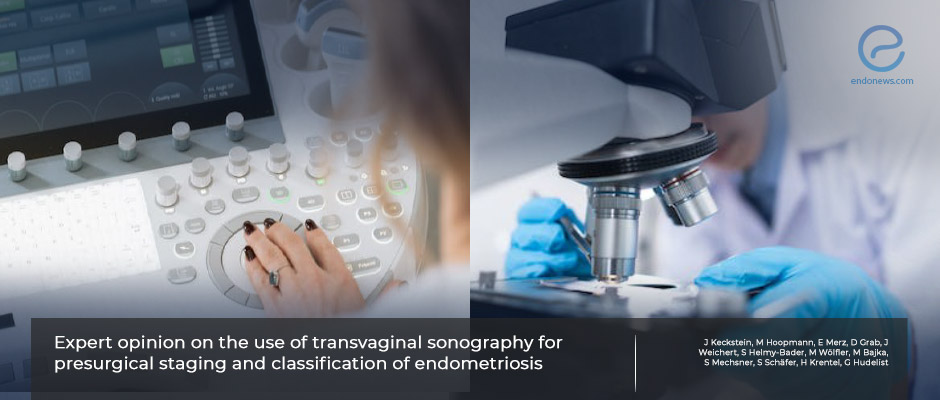Ultrasonographic Presurgical Staging and Classification of Endometriosis
Feb 1, 2023
Transvaginal ultrasonography is an effective and non-invasive diagnostic method for endometriosis.
Key Points
Highlights:
- A skilled clinician who successfully performs transvaginal ultrasonography (TVS), adding bimanual and speculum examination, can diagnose endometriosis preoperatively.
Importance:
- It will be helpful to use the Enzian classification and the definitions of IOATA (International Ovarian Tumor Analysis) and IDEA (International Deep Endometriosis Analysis) to describe endometriosis systemically during TVS.
What's done here:
- A team of authors from Germany and Austria shared information about imaging that will contribute to the future standardization of endometriosis diagnosis by ultrasound.
Outlines:
- The authors suggested that the Enzian classification is an efficient, accurate, and cost-effective tool that correlates the description of TVS with surgical findings.
- The reliability of sonographic diagnosis depends on the size and location of endometriotic lesions and is often proportional to the skill and knowledge of the examiner.
- The combination of ultrasonography and clinical examination, including bimanual palpation and speculum examination, can give a clearer view of the structures involved, especially in patients with vaginal lesions.
- Transabdominal sonography helps to complete the anatomic evaluation of the disease in cases with a severe extent of deep endometriosis, or favored when vaginal ultrasound access is not feasible
- Assessment of kidneys by transabdominal sonography is mandatory when deep endometriosis is suspected.
- Superficial peritoneal endometriosis is the only entity that cannot be reliably diagnosed by any imaging method.
- The authors recommend IOTA (the international ovarian tumor analyses) criteria while evaluating ovaries.
- The sonographic findings of deep endometriosis should be systematically recorded and described using IDEA ( International Deep Endometriosis Analyses) terminology.
- For the diagnosis of adenomyosis, TVS is superior to MRI with high specificity and sensitivity.
Lay Summary
Laparoscopic surgery is the gold standard for diagnosing endometriosis, but a preoperative imaging procedure is strongly recommended. Transvaginal sonography by a skilled examiner is not inferior to MRI diagnostics regarding sensitivity and specificity in predicting the extension of deep endometriosis.
Keckstein et al. from the Department of Obstetrics and Gynecology of the Medical University of Ulm, Germany, published a paper presenting recommendations and expert opinions in the field of non-invasive and invasive diagnostics besides the therapy of endometriosis. This paper was recently published in the Archives of Gynecology Obstetrics.
The authors shared the schematic figures of pelvic organs related to endometriotic lesions and particular sonographic outputs to draw attention to "a systemic examination procedure" according to the IDEA consensus. When documenting the dimension and the localization of endometriotic lesions, a systemic approach for sonographic workflow is needed, and specified terms, definitions, and measurements are recommended.
Regarding the endometriotic lesions that can be clearly visualized and confirmed by sonography, the exception is superficial peritoneal endometriosis. On the contrary, the definition of adenomyosis uteri by ultrasonography is superior to MRI, while MUSA criteria (Morphological Uterus Sonographic Assessment) allow this detection with high sensitivity and specificity.
The authors also claimed that Enzian classification works as a single, easily identifiable language for clinicians regarding ultrasonographic identification of endometriosis.
Research Source: https://pubmed.ncbi.nlm.nih.gov/36367580/
MRI transvaginal ultrasonography Enzian classification adenomyosis superficial peritoneal endometriosis deep endometriosis.

